Documents: Go to download!
- Owner's manual - (English)
- Getting to Know Your TV
- Completing The First-Time Setup
- Using the On-Screen Menu
- SmartCast Home
- WatchFree™
- Playing USB Media
- Playing USB Media: Music
- Playing USB Media: Video
- Playing USB Media: Photo
- Help Topics
- Specifications
- Regulatory Information
Table of contents
User Manual Vizio Smart TV.

Getting to Know Your TV
1. FRONT PANEL
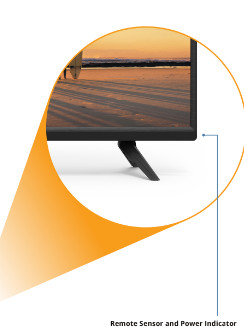
When using the remote, aim it directly at this sensor. The power indicator flashes on when the TV turns on, then goes out after several seconds.
2. REAR PANEL—V555-G4 & V755-G4

Note: The image shown here is for illustrative purposes only and may be subject to change. The actual number of ports and their locations may vary, depending on the model.
1. Power

Press to turn on the TV. Press and hold to turn the TV off.
2. Volume

Press to increase or decrease the TV volume level.
3. Input

4. HDMI

Connect an HDMI device.
5. Composite

Connect a composite.
6. Coaxial

Connect to a coaxial cable from cable, satellite, or antenna.
7. USB

Connect a USB thumb drive to play photo, music, or video.
8. Optical Audio Out

Connect to an optical/SPDIF audio device, such as home audio receiver.
9. Ethernet

Connect an Ethernet cable to modem/ router.
Connecting a device — AUDIO & VIDEO CABLE TYPES
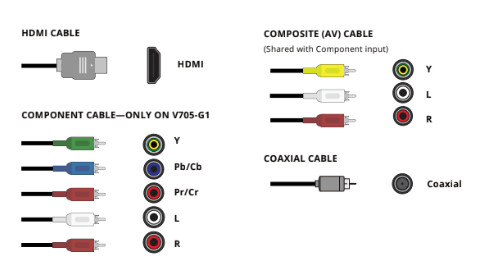
Your TV can be used to display output from most devices.
1. Verify that your device has a video port that matches an available port on the TV (HDMI, Composite, etc)
2. Connect the appropriate cable (not included) to the TV and the device
3. Turn the TV and your device on
4. Set the TV’s input to match the connection you used (HDMI-1, HDMI-2, etc)
Connecting a device — AUDIO CABLE TYPES
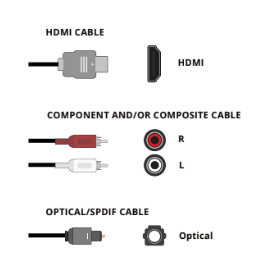
Your TV can be output sound to an audio device, such as a receiver or sound bar
1. Verify that your device has an audio port that matches an available port on the TV (optical, RCA, etc)
See other models: M656-G4 M370SL SB2020n-G6 SB46514-F6 V436-G1
2. Connect the appropriate cable (not included) to the TV and the device
3. Turn the TV and your device on.
Note: The actual ports and their locations may vary, depending on the TV model
3. WALL - MOUNTING THE TV
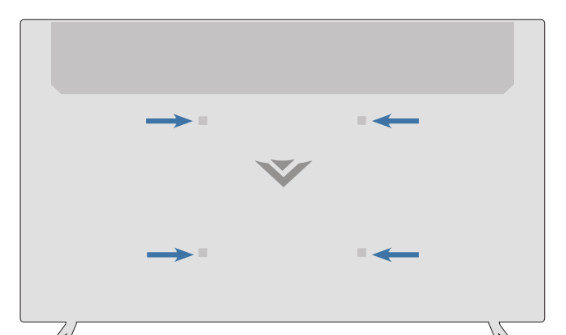
First you will need a wall mount. Consult the provided table below to find the appropriate mount for your TV.
Be sure the mount you choose is capable of supporting the weight of the TV.
To install your TV on a wall:
1. Disconnect any cables connected to your TV.
2. Place the TV face-down on a clean, flat, stable surface. Be sure the surface is clear of debris that can scratch or damage the TV.
3. If attached, remove the stands by loosening and removing the screws.
4. Attach your TV and wall mount to the wall by carefully following the instructions that came with your mount. Use only with a UL-listed wall mount bracket rated for the weight/load of your TV.

Installing a TV on a wall requires lifting. To prevent injury or damage to the TV, ask someone to help you.
WARNING: Do not use the screws that are included inside the wall mount holes to mount TV.
4. USING THE REMOTE
Note that specific buttons may vary depending on your model.

Replacing the Batteries
1. Find the notch on the back of the remote. Insert a coin and pry open the back cover.

2. Insert two batteries into the remote control. Make sure that the (+) and (-) symbols on the batteries match the (+) and (-) symbols inside the battery compartment.
3. Replace the battery cover.
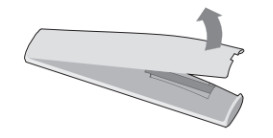
WARNING: Keep the remote control batteries away from children. It may cause choking and/or lead to a fire or chemical burn if mishandled. Do not dispose of batteries in fire. Replace only with batteries of the correct type.
TIP: When needed, VIZIO recommends replacing the batteries that came with this remote with two, new Duracell ‘AAA’ alkaline batteries.
Completing The First-Time Setup
Before you begin the first-time setup:
• Your TV should be installed and the power cord should be connected to an electrical outlet.
• If you have a wireless network, have the network password ready.
• If you are connecting to your network with an Ethernet cable, connect it to the Ethernet port on the TV.
The first time you turn on the TV, the on-screen instructions will guide you through each of the steps necessary to get your TV ready for use:
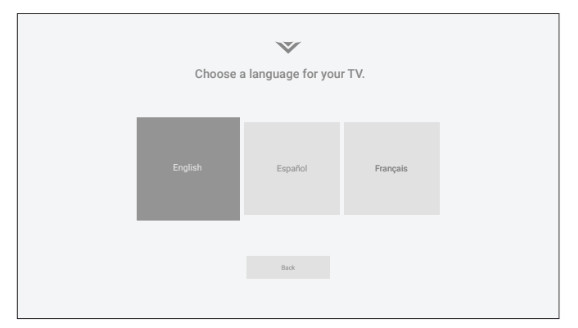
1. Choose your language.
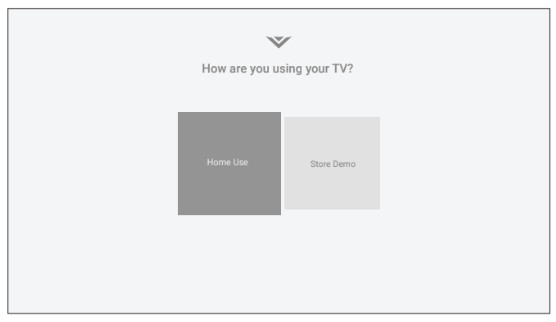
2. Choose home use.
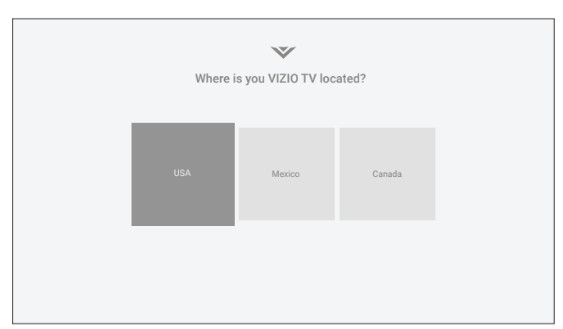
3. Choose your country.
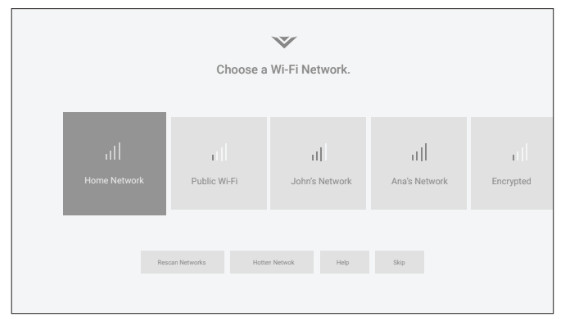
4. Choose your Wi-Fi network and enter the password.
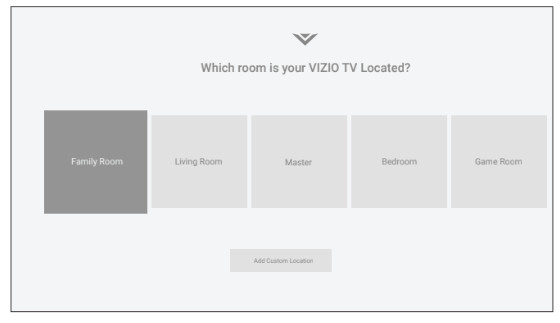
5. Name your TV.
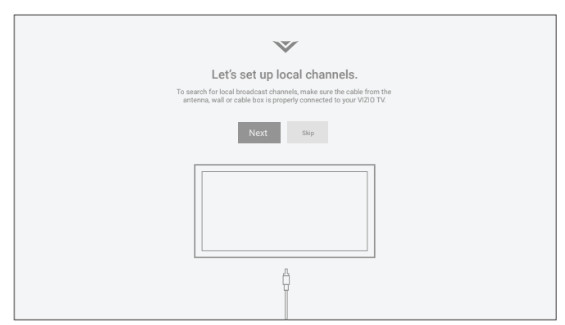
6. Scan for channels.

7. Accept the Terms & Conditions and register your device.

Using the On-Screen Menu
Your TV features an easy-to-use on-screen menu.
To open the on-screen menu, press the MENU button on the remote.
From this menu, you can:
• Adjust the picture settings
• Adjust the audio settings
• Adjust the network settings
• Set up timers
• Adjust the channel settings
• Set up closed captioning
• Name and adjust Inputs
• Adjust TV settings
• View the user manual
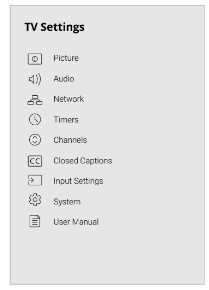
1. NAVIGATING THE ON-SCREEN MENU
To open the on-screen menu:
1. Press the MENU button on the remote.
2. Use the Arrow buttons to highlight a menu option, and press the OK button to select that option.
TIP: While navigating the on-screen menu, you can press the BACK button at any time to return to the previous menu screen. The EXIT button will close the on-screen menu.
2. CHANGING THE INPUT SOURCE
External devices, such as DVD players, Blu-ray Players, and video game consoles, can be connected to your TV. To use one of these devices with your TV, you must first change the input source using the Input menu.
To change the input sources:
1. Press the INPUT button on the remote. The input menu is displayed.
2. Use the Arrow buttons or the INPUT button on the remote to highlight the input you wish to view. The corresponding inputs are named on the back of your TV.
3. Press OK or release the INPUT button. The selected input is displayed.
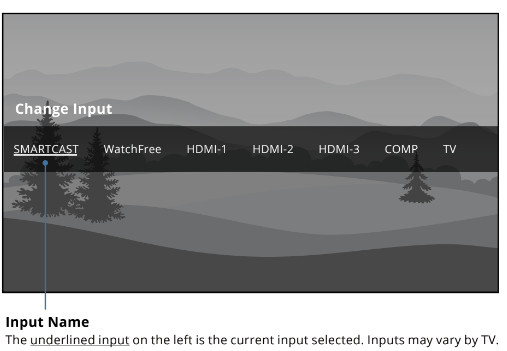
3. CHANGING THE SCREEN ASPECT RATIO
To change the screen aspect ratio:
Menu > System > Aspect Ratio
Use the Arrow buttons to highlight the aspect ratio you wish to view and press OK.
Your TV can display images in different modes: Normal, Wide, Zoom, and Panoramic.
• Normal (default) — No change to aspect ratio.
• Wide — Stretches a 4:3 aspect ratio to fill 16:9 screen. If a 16:9 image, adds black bars to top and bottom.
• Zoom — Expands image both horizontally and vertically by 14%.
• Panoramic* — Stretches a 4:3 image to fill 16:9 screen with an algorithm so the center doesn’t look stretched.
Some programs have black bars on the top or sides of the screen so that the picture keeps its original shape. Examples include widescreen movies and older TV programs.

TIP: The aspect ratio cannot be changed for Ultra HD content or HDR content.
4. ADJUSTING THE PICTURE SETTINGS
Your TV can be adjusted to suit your preferences and viewing conditions.
To adjust the picture settings:
Menu > Picture > Picture Mode
1. Use the Arrow buttons on the remote to highlight Picture Mode, then use the Left/Right Arrow buttons to change the picture mode:
• Standard — Sets the picture settings to the default settings.
• Calibrated — Sets the picture settings to values ideal for watching TV in a brightly-lit room.
• Calibrated Dark — Sets the picture settings to values ideal for watching TV in a dark room.
• Vivid — Sets the picture settings to values that produce a brighter, more vivid picture.
• Game — Reduces throughput delays and optimizes the picture settings for displaying game console output.
• Computer — Optimizes the picture settings for displaying computer output.
2. To manually change each of the picture settings, use the Up/Down Arrow buttons on the remote to highlight that picture setting, then use the Left/Right Arrow buttons to adjust the setting:
• Auto Brightness Control* — The auto brightness control detects the light levels in the room and automatically adjusts the backlight for the best picture.
• Backlight — Adjusts the LED brightness to affect the overall brilliance of the picture. Backlight cannot be adjusted when starting from some picture modes.
• Brightness — Adjusts the black level of the picture. When this setting is too low, the picture may be too dark to distinguish details. When this setting is too high, the picture may appear faded or washed out.
• Contrast — Adjusts the white level of the picture. When this setting is too low, the picture may appear dark. When this setting is too high, the picture may appear faded or washed out. If the setting is too high or too low, detail may be difficult to distinguish in dark or bright areas of the picture.
• Color — Adjusts the intensity of the picture colors.
• Tint — Adjusts the hue of the picture. This setting is useful in adjusting the flesh tones in the picture. If flesh appears too orange, reduce the level of color before adjusting tint.
• Sharpness — Adjusts the edge sharpness of picture elements. It can be used to sharpen non-HD (high definition) content; however, it will not produce detail that does not otherwise exist.
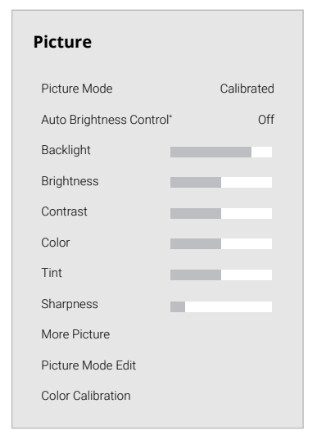
Adjusting More Picture Settings
To adjust more picture settings:
Menu > Picture > More Picture
Use the Arrow buttons to highlight the setting you wish to adjust, then press the Left/Right Arrow buttons to change the setting:
• Color Temperature — Change the white balance of the picture. Refer to the section on Adjusting the Color Temperature on page 17.
• Black Detail — Adjusts the average brightness of the picture to compensate for large areas of brightness.
• Backlight Control — When ON, it will improve the contrast ratio of the picture by adjusting backlight zones. Specific adjustments are based on content.
• Reduce Noise:
− Reduce Signal Noise: Lessens artifacts in the image caused by the digitizing of image motion content.
− Reduce Block Noise: Reduces pixelation and distortion for mpeg files.
• Game Low Latency — Reduces video delay (lag) when gaming.
• Film Mode — Optimizes the picture for watching films. Select On or Off.
• Color Space — Select color space for the source. Video sources use YCbCr, but PC uses RGB. Available for HDMI input only.
• Gamma — Set the shape of the Gamma curve. Use lower Gamma values for bright room conditions, and higher values when it’s dark.
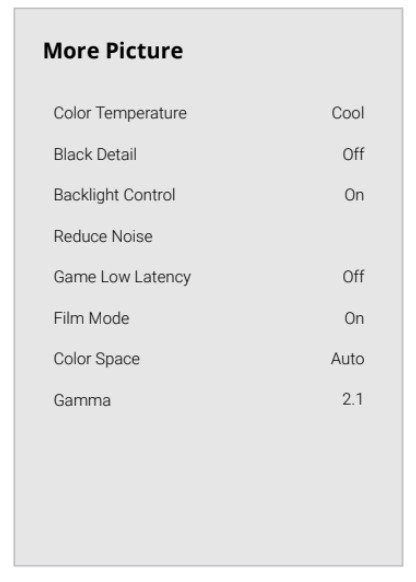
Adjusting the Color Temperature
Adjusting the color temperature changes the white balance of the picture.
To adjust the color temperature:
Menu > Picture > More Picture > Color Temperature
Use the Arrow buttons on the remote to highlight a color temperature preset and then press OK.
• Normal — Optimized for television viewing.
• Cool — Produces a blue-hued picture.
• Computer — Optimizes the picture for use as a PC monitor.
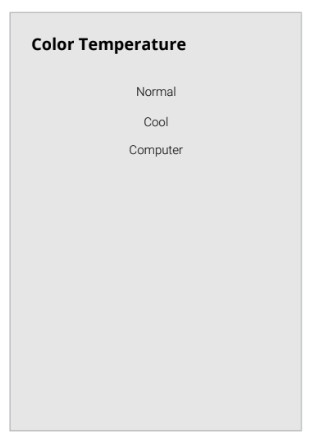
Adjusting the Picture Mode Edit Settings
Picture Mode Edit Settings allow you to make precise adjustments to the picture.
To adjust the Picture Mode Edit settings:
Menu > Picture > Picture Mode Edit
Use the Arrow buttons to highlight the setting you wish to adjust, then press OK to change the setting:
• Save Picture Mode — Save a custom picture mode.
• Lock Picture Mode — Prevent changes to custom picture modes.
• Reset Picture Mode — Reset the picture mode settings to factory default values. Only available on customized preset modes.

Saving a Custom Picture Mode
Custom picture modes allow you to save a group of custom settings for various
viewing conditions and video sources.
To save a custom picture mode:
Menu > Picture > Picture Mode Edit > Save Picture Mode > Enter a Name
>Save
• Changes made while on any preset picture mode will add an asterisk on the top right corner of the preset mode.
• The custom picture mode is not automatically saved.
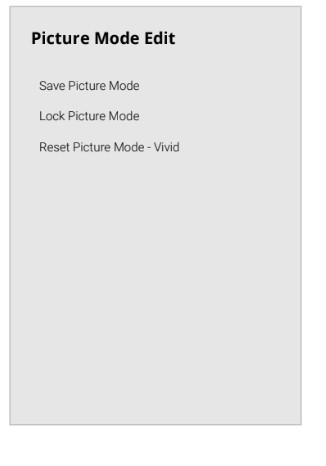
Locking/Unlocking a Custom Picture Mode
Custom picture modes can be locked/unlocked with a unique PIN to prevent
accidental changes to their settings. If not previously set, you can set up your system
PIN code here.
To lock all custom picture modes:
Menu > Picture > Picture Mode Edit > Lock
Picture Mode > Enter Your PIN > Save
To unlock all custom picture modes:
Menu > Picture > Picture Mode Edit > Lock
Picture Mode > Off > Enter Your PIN

Deleting a Custom Picture Mode
Custom picture modes that are no longer needed can be deleted.
To delete a custom picture mode:
Menu > Picture > Picture Mode Edit > Delete Picture Mode > Delete
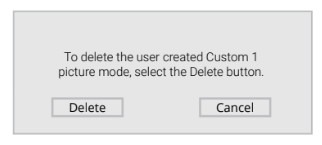
Resetting a Picture Mode
A preset picture mode that has been edited can be restored to the factory
default settings.
To reset a customized preset picture mode:
Menu > Picture > Picture Mode Edit > Reset Picture Mode > Reset
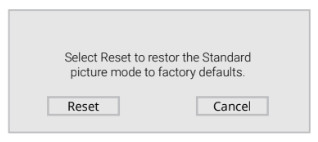
Adjusting the Color Tuner Settings
The Color Tuner settings allow you to adjust the color management system, 2 point white balance, 11 point white balance, turn color channels off for testing, and display SMPTE, flat, ramp, and uniformity analyzer test patterns.
WARNING: The Color Tuner, 11 Point White Balance, and test patterns allow technicians to manually calibrate the TV. Calibration requires specialized training, an input with precisely set colors, and a specialized light meter.
To access the color tuner table:
Menu > Picture > Color Calibration > Color Tuner
To turn color channels off and on:
1. Use the Arrow buttons on the remote to highlight Red, Green, or Blue.
2. Press the OK button to turn the color channel off or on. An X appears over a color channel that has been turned off.
3. Only two color channels can be turned off at the same time.
To adjust the color management system/2 point white balance settings:
1. Use the Arrow buttons on the remote to highlight the Hue, Saturation,
Brightness, Offset, or Gain of the color you wish to adjust. Press the OK button.
2. Use the Left/Right Arrow buttons to adjust the value. When you are finished
press the OK button to save the setting.
To adjust the 11 Point White Balance settings:

1. From the Color Tuner table, use the Arrow buttons to highlight the top bar and then press the Left/Right Arrow buttons until the 11 POINT WHITE BALANCE menu is displayed.

2. Use the Arrow buttons on the remote to highlight the Gain and Color values you wish to adjust. Press the OK button and use the Left/Right Arrow buttons to adjust the value. When you are finished, press the OK button to save the setting.
To show or hide the SMPTE Test Pattern:
Menu > Picture > Color Calibration > Color Tuner > SMPTE Test Pattern

1. Use the Arrow buttons on the remote to highlight Off. Use the Left/Right Arrow buttons to select On to show the SMPTE Pattern.
—or—
2. To hide the SMPTE Test Pattern, use the Left/Right Arrow buttons to select Off.
To show or hide the Flat Test Pattern:
Menu > Picture > Color Calibration > Color Tuner > Flat Test Pattern

1. Use the Arrow buttons on the remote to highlight Off. Use the Left/Right Arrow buttons to select the percentage brightness for the flat test pattern. Selecting a percentage immediately shows the flat pattern at that brightness.
—or—
2. To disable the Flat Test Pattern, use the Left/Right Arrow buttons to select Off.
To show or hide the Ramp Test Pattern:
Menu > Picture > Color Calibration > Color Tuner > Ramp Test Pattern

1. Use the Arrow buttons on the remote to highlight Off. Use the Left/Right Arrow buttons to select the color for the ramp test pattern. Selecting a color immediately shows that color ramp.
—or—
2. To hide the Ramp Test Pattern, use the Left/Right Arrow buttons to select Off.
To show or hide the Uniformity Analyzer Test Pattern:
Menu > Picture > Color Calibration > Color Tuner > Uniformity Analyzer Test Pattern

1. Use the Arrow buttons on the remote to highlight Off. Use the Left/Right Arrow buttons to select On to show the Uniformity Analyzer Test Pattern.
—or—
2. To hide the Uniformity Analyzer Test Pattern, use the Left/Right Arrow buttons to select Off.
5. ADJUSTING THE AUDIO SETTINGS
To adjust the audio settings:
Menu > Audio > OK
Use the Arrow buttons to highlight the setting you wish to adjust, then press Left/Right Arrow buttons to change the setting:
• Speakers — Turn the built-in speakers On or Off.
• Volume Control Display — Turn the on-screen volume display slider On or Off.
• Surround Sound — Surround sound uses DTS TruSurroundTM to deliver an immersive surround sound experience from the TV’s internal speakers. TruSurround completes the entertainment experience by providing deep, rich bass, crisp details, and clear, intelligible dialog. Select On or Off.
• Volume Leveling — Volume leveling uses DTS TruVolumeTM to maintain consistent volume levels during transitions between program content, AV formats, and input sources. Select On or Off. In a few cases, volume leveling may artificially suppress volume increases, making it difficult to hear dialog or flattening sudden noises. If this occurs, turn volume leveling off.
• Balance — Adjusts the loudness of the audio output from the left and right speakers.

• Lip Sync — Adjusts the synchronization between the display image and the accompanying audio track.
• Digital Audio Out — Changes the type of processing for digital audio out and HDMI ARC output when connected to a home theater audio system. Select Auto, PCM, Dolby D or Bitstream.
- To hear talk back when Talk Back function is enabled, digital audio out must be set to PCM.
• Analog Audio Out — Sets the volume control properties for the RCA connector when connected to a home theater audio system. Select Variable if you are controlling the volume with the TV’s volume controls, or select Fixed if an external audio device (sound bar or AV receiver) will control the volume.
6. ADJUSTING THE NETWORK SETTINGS
Your TV is Internet-ready, featuring both an Ethernet port and built-in high-speed wireless internet.
TIP: If your TV is connected to a network with an Ethernet cable, you will not see the wireless network connection menu. You must unplug the Ethernet cable to set a wireless network connection.
Connecting to a Wireless Network
To connect to a wireless network whose network name (SSID) is being broadcast:
Menu > Network > Choose your network > Enter in the password > Connect
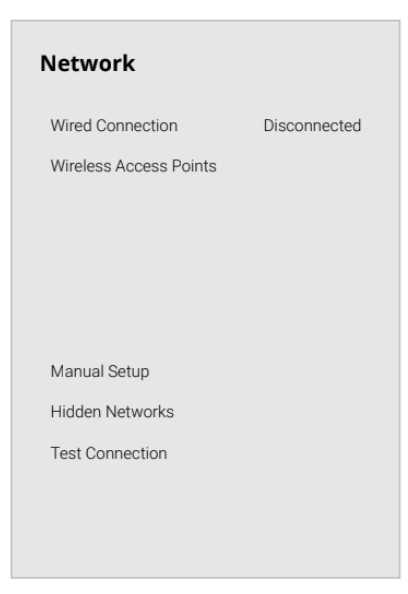
If you do not see your wireless network displayed, click on:
More Access Points > Highlight your wireless network > Enter in the password > Connect
Changing the Manual Setup Settings
Advanced users can fine-tune the network settings using the Manual Setup feature. The security settings on your router may require you to enter the TV's MAC address.
To change advanced network settings:
Menu > Network > Manual Setup > Off
1. Use the Arrow and OK buttons to adjust each setting:
• IP Address — The IP address assigned to the TV.
• Subnet Mask — The subnet Exit 2D.
• Default Gateway — Your network’s default gateway address.
• Pref. DNS Server — Your preferred domain name server address.
• Alt. DNS Server — Your alternate domain name server address.
2. Use the Arrow buttons on the remote to highlight Save and press OK.
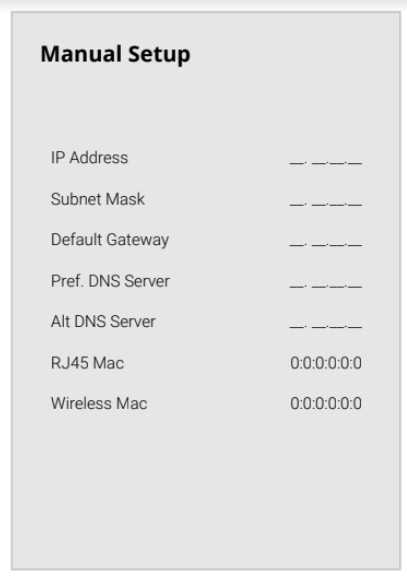
To find the TV’s MAC address:
Menu > Network > Manual Setup
You can find your TV's MAC address at the bottom of the list. The MAC addresses for the connections in use are displayed:
• RJ45 MAC — The Ethernet or RJ45 MAC address may be needed to set up your network when you have connected the TV to your network when you have connected the TV to your network with an Ethernet (Cat 5) cable.
• Wireless MAC — The Wireless (Wi-Fi) MAC address may be needed to connect your TV to your network with Wi-Fi.
Connecting to a Hidden Network
To connect to a wireless network whose network name (SSID) is not being broadcast:
Menu > Network > Hidden Network > Enter the Access Point Name >
Connect > Enter in the password
Testing Your Network Connection
To test your network connection:
Menu > Test Connection
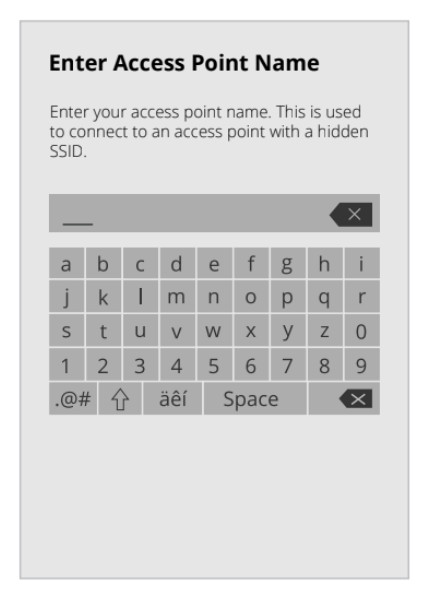
7. SETTING TIMERS
When activated, the TV’s timer will turn the TV off after a set period of time.
To setup a sleep timer:
Menu > Timers
Use the Left/Right Arrow buttons on the remote to highlight the period of time after which you want the TV to go to sleep: 30, 60, 90, 120, or 180 minutes. If you don’t want the sleep timer to activate, change the setting to Off.
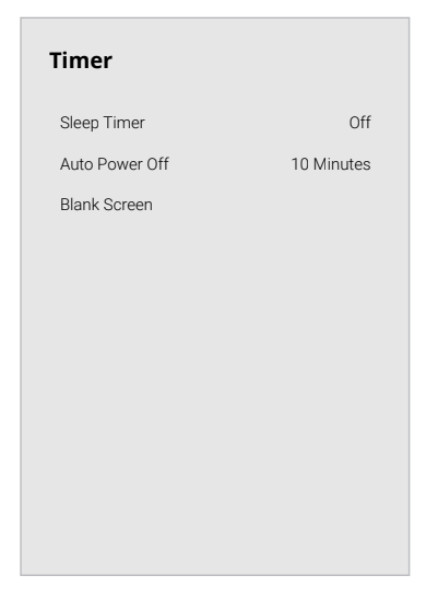
Setting the Auto Power Off Feature
To help save energy, your TV is set by default to turn off after 10 minutes without a
video or audio signal. This feature can be deactivated.
To set the Auto Power Off feature:
Menu > Timers > Auto Power Off > Off
Using the Blank Screen Feature
To help save LED life, your TV screen can turn on or off while audio is streaming.
To use the Blank Screen feature:
Menu > Timers > Blank Screen
To exit Blank Screen, press any key (except the volume and mute keys).
8. SETTING UP CHANNELS
You can use the TV’s Channels menu to:
• Find channels
• Select channels to skip
• Select analog audio mode
• Select the language for digital audio
• Set parental controls

Scanning for Channels
The TV may need to scan for channels before it can display programs and their associated information. A channel scan is required for free over-the-air channels (using an antenna) and cable channels from an out-of-the-wall connection (without a cable box). Moving the TV to an area with different channels requires the TV to scan for channels again.
To perform an Auto Channel Scan:
Menu > Channels > Find Channels
Wait until the channel scan is 100% complete. Highlight Done and press OK.
• If the channel scan is canceled, the channels that were already discovered are retained. A new channel scan will clear all channels.
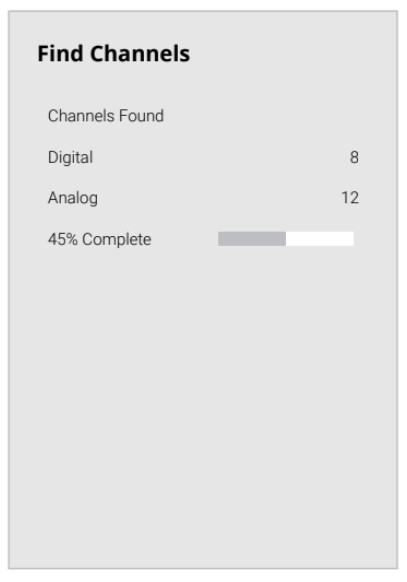
Skipping Channels
After a channel scan is completed, you may find that some channels are too weak to watch comfortably. There may also be some channels you do not want to view. You can remove these channels from the TV’s memory with the Skip Channel feature.
WARNING: Channels that have been removed with the Skip Channel feature can still be viewed if the channel is entered using the Number Pad. If you wish to completely block a channel from being viewed, use the parental controls.
To remove a channel:
1. From the CHANNELS menu, highlight Skip Channel, and press OK. The SKIP CHANNEL menu is displayed.
2. For each channel you wish to remove, use the Up/Down Arrow buttons on the remote to highlight the channel and press OK. A P appears to the right of each channel you select.
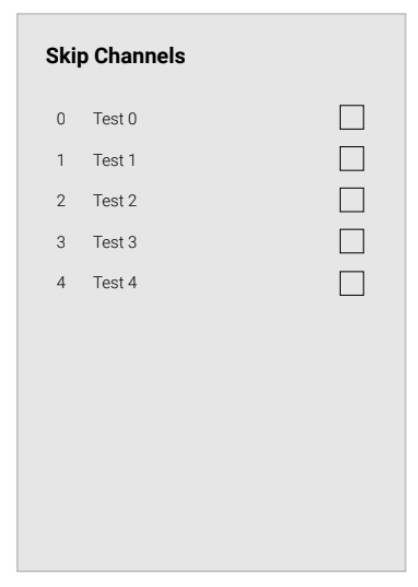
9. LISTENING TO ALTERNATE AUDIO
Changing the Analog Audio Language
Some analog over-the-air (free) and cable channels broadcast programs in morethan one language. The TV’s Analog Audio feature allows you to listen to audio in analternate language using Secondary Audio Programming (SAP).
WARNING: Not all programs are broadcast in SAP. The Analog Audio Language feature only works when the program being viewed is being broadcast with Secondary Audio Programming.
To use the Analog Audio feature:
Menu > Channels > Analog Audio
• Stereo — More than one speaker channel is being used. Sounds may be dispersed through different speakers depending on how the audio is programmed.
• SAP (Secondary Audio Program) — Typically used for audio in a different language other than the native one used in the program.
• Mono — All speakers are producing the same sound; there is no distinction between left or right sounds.

To use the Digital Language feature:
Menu > Channels > Digital Audio
Select the preferred audio language. Available languages or video description depend on the broadcast content.

10. USING PARENTAL CONTROLS
The TV’s parental controls allow you to prevent the TV from displaying certain
channels or programs unless a PIN is used.
Accessing the Parental Controls Menu
To access the PARENTAL CONTROLS menu you must first set up a system PIN:
Menu > Channels > Parental Controls > Enter in PIN
The Parental Controls menu only appears when:
• You are using the tuner to receive your TV signals, such as when you are using an antenna for Over-the-Air signals or when connected to cable TV directly from the wall (no cable box).
• You have a device connected using a composite video cable or a coaxial cable, such as a VCR, satellite or cable box, or DVR.
TIP: Other devices have their own parental control settings.
Enabling or Disabling Program Ratings
To manage program content according to its rating, you must first enable the
Program Rating feature.
To enable or disable the Program Rating feature:
Menu > Channels > Parental Controls > Locks > ON/OFF
Locking and Unlocking Channels
When a channel is locked, it cannot be accessed. Locking a channel is a good way to
prevent children from viewing inappropriate material.
To lock or unlock a channel:
Menu > Channels > Parental Controls > Channel Locks
Highlight the channel you want to lock or unlock and press OK.
• When a channe is locked, the Lock icon appears  locked. The channel is not accessible unless the system PIN is entered.
locked. The channel is not accessible unless the system PIN is entered.
• When a channel is unlocked, the Lock icon appears  unlocked.
unlocked.
Blocking and Unblocking Content by Rating
A channel may sometimes broadcast programs that are meant for a variety of audiences (some for children and some for adults). You might not want to block the channel completely using a channel lock, but you can block certain programs from being viewed.
You can use the TV’s Rating Block feature to block content based on its rating.
To block or unblock content by its rating:
1. From the Parental Controls menu, highlight the content type you want to adjust and press OK:
• USA TV — USA television program broadcasts.
• USA Movie — USA movie broadcasts.
• Canadian English — Canadian English television program broadcasts.
• Canadian French — Canadian French television program broadcasts.
2. For each rating type you want to block or unblock, use the Arrow buttons to highlight the rating type and press OK.
• When the rating type is blocked, the Lock icon appears  locked. Content with this rating and all higher ratings cannot be viewed.
locked. Content with this rating and all higher ratings cannot be viewed.
• When the rating type is unblocked, the Lock icon appears  unlocked. Content with this rating and all lower ratings can be viewed.
unlocked. Content with this rating and all lower ratings can be viewed.
• If you want to block all unrated content, highlight Block Unrated Shows and use the Arrow buttons on the remote to select On.
11. SETTING UP CLOSED CAPTIONING
Your TV can display closed captions for programs that include them. Closed captions display a transcription of a program’s dialogue.
TIP: If the program you are viewing is not being broadcast with closed captions, the TV will not display them.
To activate or deactivate closed captions:
Menu > Closed Captions > Closed Captions > Off/On
1. Use the Arrow buttons on the remote to highlight either Analog or Digital Closed Captions.
2. Use the Left/Right Arrow buttons on the remote to select the caption channel you wish to display, then press EXIT.
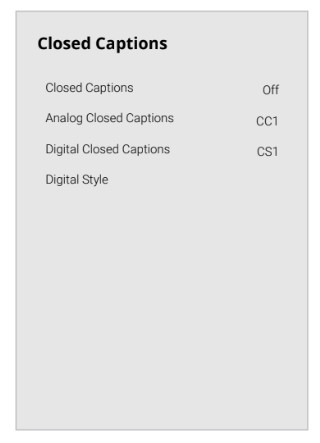
TIP: The Closed Captions menu does not appear when an HDMI input is selected. Closed captions are available when using the tuner or a composite video cable.
Changing the Appearance of Digital Closed Captions
Digital closed captions can be displayed according to your preference. See the diagram on the next page for an explanation of the parts of the closed caption area.
To change the appearance of digital closed captions:
Menu > Closed Captions > Digital Style
1. Use the Left/Right Arrow buttons on the remote to select Custom. The Digital Style menu appears as shown.

Typical choices include:
• Opaque background, transparent window — Only a strip of background appears behind the text, expanding as the text appears. This is the typical "As Broadcast" mode.
• Opaque background and window in the same color — When text appears, the entire line fills with color at once.
In the example, the closed caption text is green, the background is black, and the window is red.
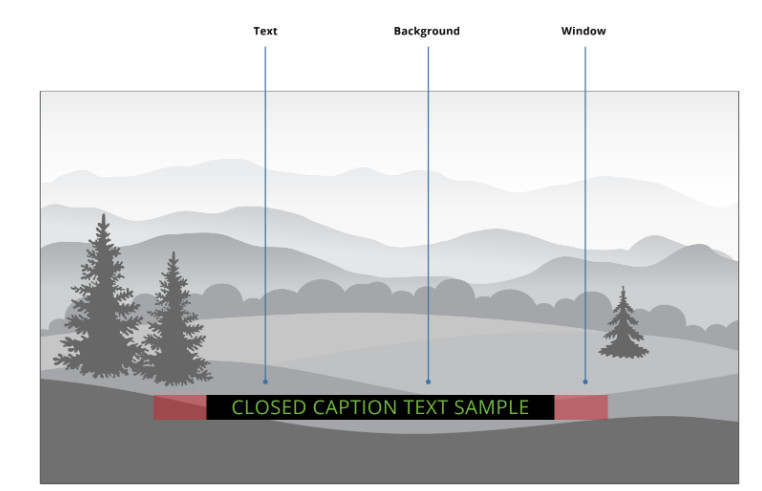
12. CHANGING INPUT SETTINGS
To access input settings menu:
Menu > Input Settings
Highlight the input device that you want to view/change and press OK.
Renaming Devices on the Input Menu
You can rename the inputs to make them easier to recognize on the Input menu. For example, if you have a DVD player connected to the component input, you can rename that input to display “DVD Player.” See Changing the Input Source on page 14.
To change the name of an input:
Menu > Input Settings
To use a preset input name:
• Highlight the Name Input row and press OK.
• Highlight the input name and use the Left/Right Arrow buttons on the remote
to cycle through preset input names
—or—
To enter a custom name:
• Highlight the Name Input row and press OK.
• Enter your custom label using the on-screen keyboard and press OK.
TIP: You cannot rename the tuner or WatchFree input.
Other settings include the following:
• Full UHD Color* — expanded color display.
• Picture Size* — configure the display size to enlarge or shrink the image to fill the screen.
• Picture Position* — move the vertical and horizontal position of the picture in relation to the screen.
• Hide from Input Source — hide inputs that are not being used. Hidden inputs will not be displayed in the input list.
*Only available if there is an input source. Not available for WatchFree. Menu items will be greyed out if not available.
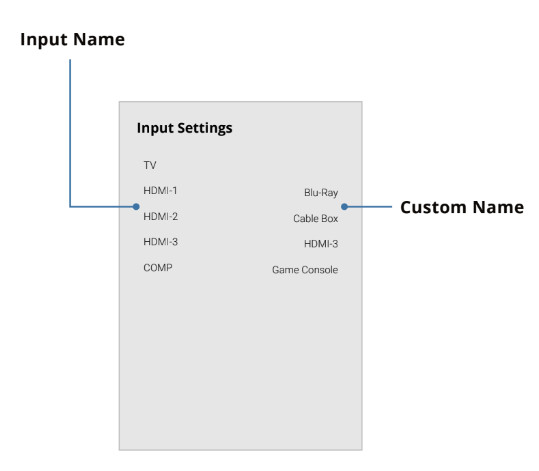
13. CHANGING THE TV SETTINGS
Using the System menu, you can:
• Check for updates
• View system information
• Change the on-screen menu language
• Set time zone and local settings
• Adjust the CEC settings
• Adjust the power mode settings
• Adjust to preserve aspect ratio or fill the screen
• Name the TV
• Review and maintain the list of paired devices
• Adjust accessibility settings
• Reset the TV settings and setup administrative controls
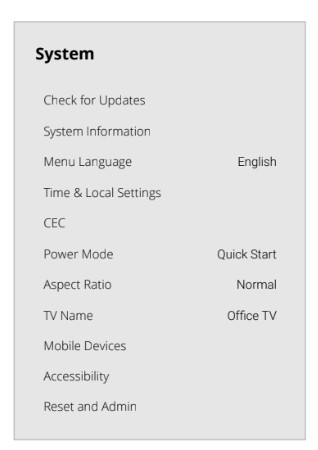
Checking for System Updates
To check for a system update:
Menu > System > Check for Updates
If an update is found, the TV will ask to confirm the update. If no update is found, the screen will note The TV is up-to-date.
Viewing System Information
To view technical data and status information about your TV and network connection:
Menu > System > System Information
Changing the On-Screen Menu Language
Your TV can display the on-screen menu in different languages.
To change the on-screen menu language:
Menu > System > Menu Language
Highlight your preferred language (English, Español, or Français) and press OK.

Setting the Time and Local Settings
To ensure the correct time is displayed when you press the INFO button, set the TV’s time zone:
Menu > System > Time & Local Settings > Time Zone
To turn Daylight Saving Time on or off:
1. Highlight Daylight Saving Time and press OK. The Daylight Saving Time menu is displayed.
2. Choose On if it is currently Daylight Savings Time, Off if it is Standard Time, or Auto to have the system automatically detect Daylight Savings Settings.
Adjusting the CEC Settings
The CEC function on your TV enables you to control devices connected to HDMI (ARC) input with the included remote, without any programming. Using CEC, your VIZIO TV remote can control:
• Power On/Off
• Volume
• Mute
WARNING: Not all HDMI devices support CEC. See your device’s user manual for details.
To enable, disable, or adjust CEC settings:
Set up your audio device and connect it to the HDMI-1(HDMI Arc) input on the TV. On your audio device, select the HDMI ARC input.
Menu > System > CEC
Select a setting and then press OK.
• CEC: To use CEC, you must select Enable.
• Device Discovery: To determine if your device is connected and supports CEC, select Device Discovery and then press OK.
Adjusting the Power Mode
Your TV is set to Eco Mode by default. When the TV is powered off, the Eco Mode setting uses less than 0.5W of power. Quick Start Mode enables your display to power on faster and also to turn on when powered from another device (such as when you are casting onto the TV).
To switch between Eco Mode and Quick Start Mode:
Menu > System > Power Mode
Highlight either Eco Mode or Quick Start Mode and press OK.
WARNING: Please note that by changing this setting the energy consumption required to operate this device will change.
Changing the TV Name
Naming your TV helps differentiate it from other cast devices you may have in your home.
To edit your TV name:
Menu > System > TV Name > Enter a Name
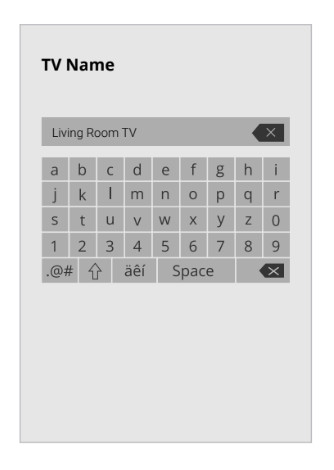
Managing Mobile Devices
Your TV can be paired with a mobile device so you can easily control your TV across multiple devices.
To see a list of paired devices or unpair a device:
Menu > System > Mobile Devices
Highlight a device name to delete it and press OK.
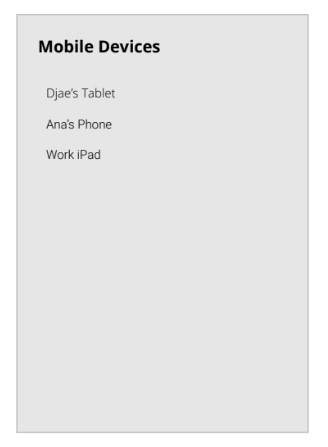
Accessibility Settings
VIZIO is committed to providing intuitive, user-friendly products. Your new VIZIO TV
offers several accessibility features that can help you with easy navigation.
To access the Accessibility menu:
Menu > System > Accessibility
1. Talk Back — Enables your TV to speak all settings changes and adjustments using the remote in English.
2. Speech Rate* — Adjusts the rate in which Text-to-Speech is spoken. Select Slow, Normal (Default), or Fast.
3. Zoom Mode — Enlarges a section of the screen by approximately 200%.
4. Video Description — If included by the broadcaster, provides a narrated description of the action for the content.
To access the Closed Caption menu:
Menu > Closed Captions
To access the Video Description menu:
Menu > Channels > Digital Audio

14. USING THE RESET & ADMIN MENU
You can use the TV’s Reset & Admin menu to restore the TV to its factory default settings as well as access other system settings.
Using the RESET & ADMIN menu, you can:
• Reset the TV to factory settings
• Force the system to power off and on
• Create a system pin code to lock content and picture settings
• Turn USB power on or off.
• Enable or disable program offers and suggestions
• Enable or disable anonymous debug data for system performance.
• Start or stop the store demo mode

Restoring the TV to Factor Dèault Settings
All of the on-screen menu settings can be reset to the factory defaults.
To restore the TV to its factory default settings:
Menu > System > Reset & Admin > Reset to Factory Settings
1. If you set a system PIN code, enter it now.
2. The TV displays, “Select Reset to restore all TV settings to factory defaults."
3. Highlight Reset and press OK.
4. Wait for the TV to turn off. The TV will turn back on shortly afterward and the
setup process will begin.
Performing a Soft Power Cycle
A soft power cycle forces the TV to turn off then on again.
Menu > System > Reset & Admin > Soft Power Cycle > YES
WARNING: If you restore the TV to the factory default settings, all changes you have made to the settings will be lost. This includes any wireless or picture settings.
Turning the Power Indicator On or Off
The power indicator on the front of your TV normally does not glow when the TV is on. You can change this setting if you prefer the light to be on.
To turn the Power Indicator Light On or Off:
Menu > System > Reset & Admin > Power Indicator > ON/OFF
Setting a System PIN
You can set a system pin to lock content and picture modes, as well as prevent accidental system resets. The first time you select System PIN code, you will need to create a PIN.
To create a PIN.
Menu > System > Reset & Admin > System PIN Code > Enter Your PIN > Save
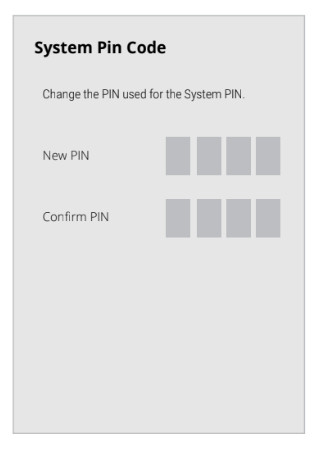
Using the USB Power Feature
The USB port can be used to charge devices.
The two options for this feature are:
• Always On — Power is always available.
• Off When TV Off — Power is only available with the TV is on.

About Viewing Data
Video ACR collects data related to publicly available content displayed on your television/display, such as the identity of your broadcast, cable, or satellite television provider, and the television programs and commercials viewed (including time, date, channel, and whether you view them live or at a later time). We also collect unique identifiers about this TV, including the IP address. This data is collectively referred to as “Viewing Data”. When ACR collection is turned on, we may share Viewing Data with authorized data partners including analytics companies, media companies and advertisers. VIZIO and its authorized data partners use Viewing Data to generate summary analysis and reports of how users engage with content on their TVs and other devices. VIZIO Viewing Data is sometimes enhanced with household demographic data and data about digital actions (e.g. digital purchases and other consumer behavior taken by
devices associated with the IP Address we collect). Viewing Data also enables our authorized data partners to deliver advertising relevant to your profile that you might find useful, both on the VIZIO TV/display and other devices sharing your IP Address. Viewing Data is also used to help content publishers, broadcasters or content distribution services create or recommend more relevant entertainment based on summary insights, as well as helps us improve the design of our products,
software and services.
15. USING THE INFO WINDOW
Press the INFO button one time to display:
• TV name
• Current input
• Picture mode
• Audio type
• Network name
• Time
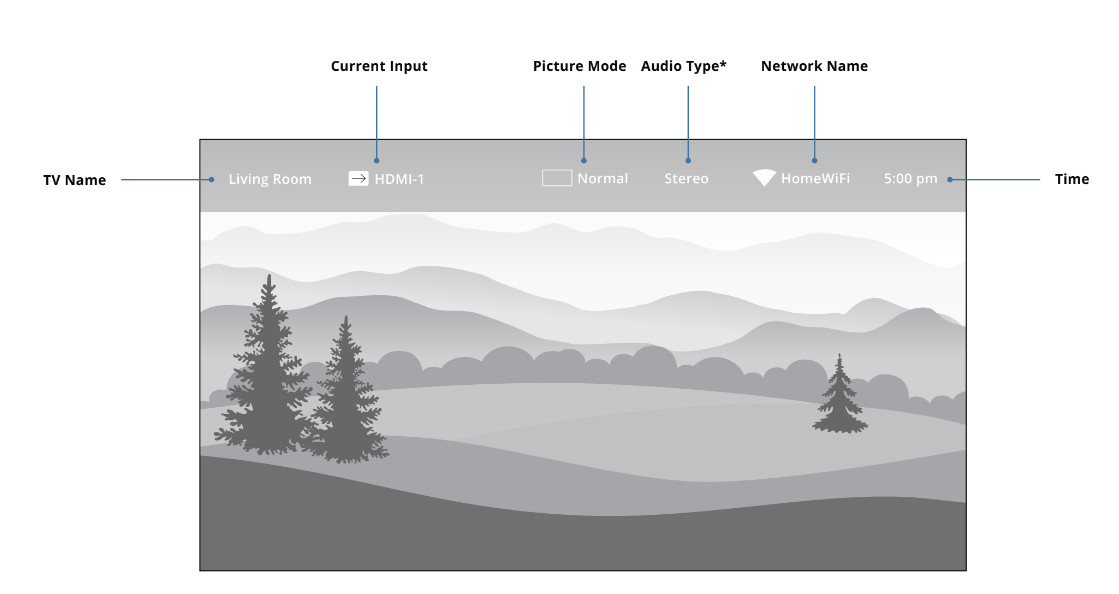
*When TV speakers are off and Dolby Atmos content is passed through the TV to a sound bar or other audio device, the Dolby Atmos icon  will display with "Audio Out."
will display with "Audio Out."
SmartCast Home

What is SmartCast Home?
SmartCast Home lets you discover, stream, and control your content like never before! Access top apps, like Netflix, Hulu, and Amazon Prime Video, by using the remote to easily browse and launch content directly from the home screen. SmartCast Home makes finding something to watch easy and fun.
How to Launch SmartCast Home:
Begin streaming with SmartCast Home by:
• Press the SmartCast Home or
or  button on your remote.
button on your remote.
—or—
• Select SmartCast from the list of inputs.
What you can do with SmartCast Home
• Stream high quality entertainment.
• Launch top tier apps directly from the home screen.
• Unlock your photos and videos by mirroring your laptop or mobile device onto your TV.
• Rearrange apps on your home screen just the way you like it.
• Works with Google Assistant and other popular voice assistants.
Control your TV with the SmartCast MobileTM App
Download the VIZIO SmartCast Mobile app and turn your smartphone into a remote to control and configure your TV.
o download

With SmartCast Mobile, you can:
• Power on/off devices, play/pause content, and modify advanced settings, allfrom the palm of your hand.
• Easily enter text onto your TV/display from your mobile device using a full keyboard.
• Browse and discover movies, TV shows, music, live streams, and more, across multiple apps at once.
• Access a quick look at show ratings, synopsis, cast, crew, clips, and other details.
WatchFree™
What is WatchFree?
VIZIO WatchFree takes your cord-cutting entertainment experience one step further! With the simple press of a button, enjoy free streaming TV with over 100 live TV channels to choose from – news, movies, sports, comedy, music and more. A built-in on-screen guide makes finding something to watch easier than ever. And it’s all FREE – no fees, no subscriptions, or logins.
What you can do with WatchFree
• Stream over 100 live TV channels absolutely free – news, movies, sports, comedy, music and more.
• Navigate through channels, organized by genre, with an intuitive on-screen guide.
• Watch 1000’s of free movies from major studios.
• Watch the best of internet TV.
• No logins, subscriptions or transactions fees.
How to Launch WatchFree
To launch and begin watching entertainment offered on WatchFree:
• Press the WatchFree button or the INPUT button on your remote.
-or-
• Simply select the WatchFree app logo from the SmartCast Home app row.
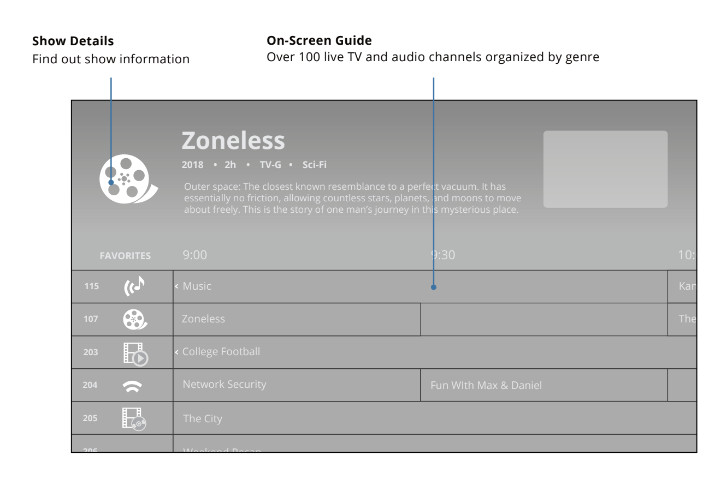
Playing USB Media
The USB Media Player allows you to connect a USB flash drive to your TV and play music, video, or photos.
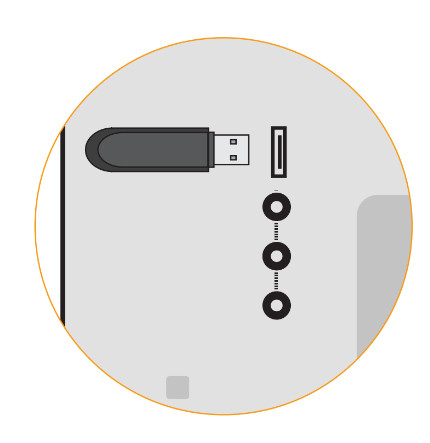
Preparing Your USB Drive to Play USB Media
To display USB media, you must first save your videos onto a USB flash drive:
• The USB flash drive must be formatted as FAT32.
• Files on the USB flash drive must end in a supported file extension ( .mp3, .jpg, etc).
• The player is not designed to play media from external hard drives, MP3 players, cameras, or smartphones.
Displaying USB Media
To display your USB media:
1. Connect your USB flash drive to the USB port on the side of the TV.
2. The TV will recognize the USB. Use the Arrow Keys on the remote to select the content you want to play.
—or—
3. Select USB from the bottom streaming icons on the SmartCast HomeSM page.
TIP: You can display your photos in Fullscreen. Select the photo, press OK, then highlight Fullscreen and press OK.
Removing the USB Drive from the TV
To safely remove your USB flash drive from the TV:
1. Turn the TV off.
2. Disconnect your USB flash drive from the USB port on the side of the TV.
WARNING: Do not remove the USB flash drive while the TV is on. Doing so may damage the drive.
Playing USB Media: Music
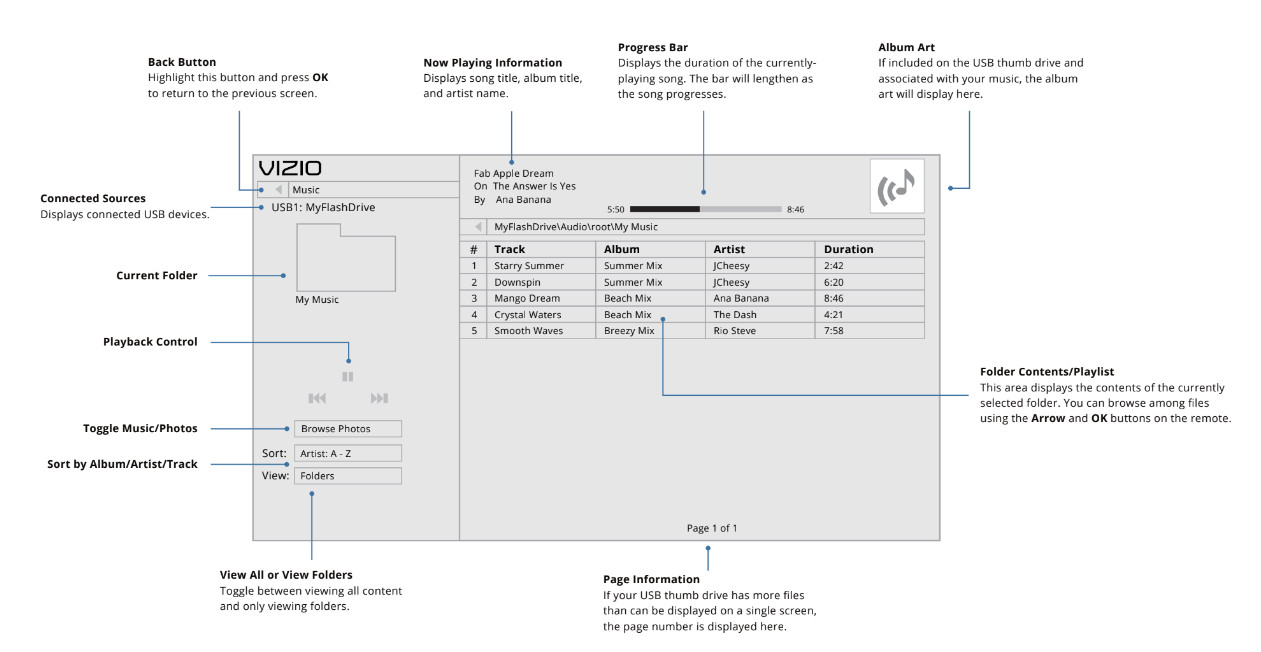
Playing USB Media: Video
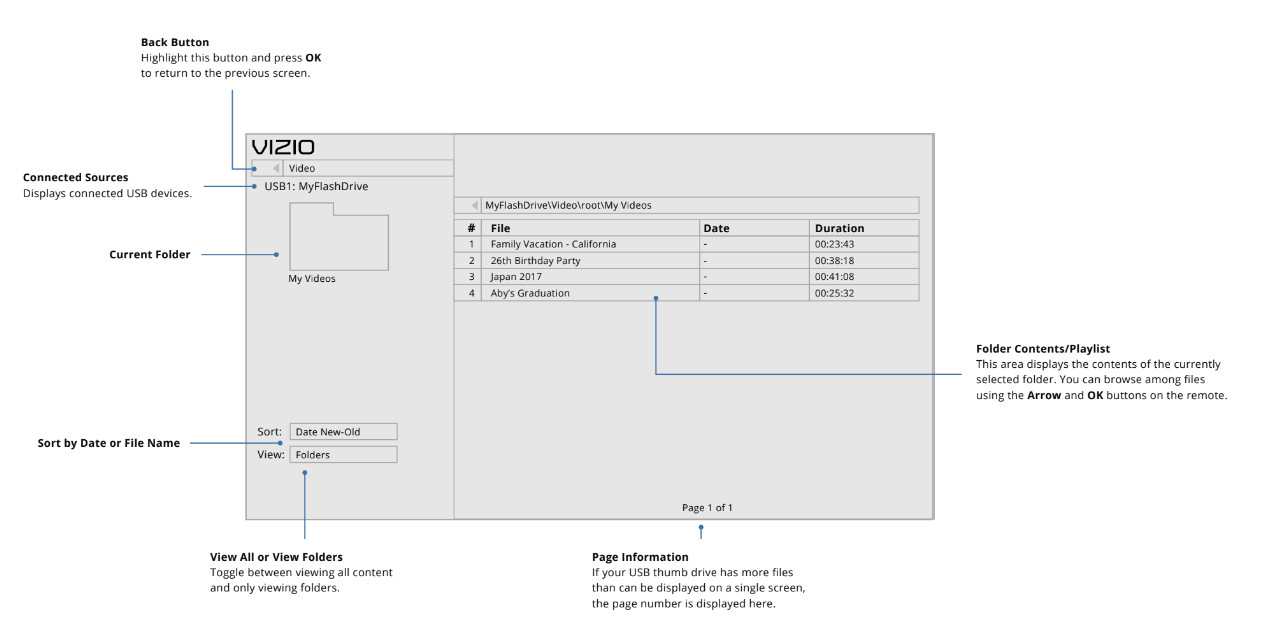
Playing USB Media: Photo

Help Topics
The remote is not responding.
• Make sure the batteries are properly inserted matching the - and + symbols.
• Replace the batteries with fresh ones.
The TV displays “No Signal.”
• Press INPUT button on the remote control to select a different input source.
• If you are using cable TV or antenna connected directly to the TV, scan for channels. See Scanning for Channels on page 24.
There is no power.
• Ensure the TV is plugged into a working electrical outlet.
• Ensure the power cable is securely attached to the TV.
• Press the Power/Standby button on the remote or on the back of the TV to
turn the TV on.
The power is on, but there is no image on the screen.
• Ensure all cables are securely attached to the TV.
• Ensure all devices are connected correctly. Devices differ; see your device’s user
manual for details.
• Adjust Brightness, Contrast, or Backlight. See Adjusting the Picture Settings on
page 16.
• Press the INPUT button on the remote to select a different input source.
The sound is flat or dialog is not audible.
• Turn off Volume Leveling. See Adjusting the Audio Settings on page 21.
The colors on the TV don’t look right.
• Adjust the Color and Tint settings in the Picture menu. See Adjusting the Picture
• Select a pre-set picture mode. VIZIO recommends selecting Calibrated.
• Check all cables to ensure they are securely attached.
There is no sound.
• Press Volume Up on the remote control.
• Press the Mute button on the remote to ensure mute is off.
• Check the audio settings. See Adjusting the Audio Settings on page 21.
• Check the audio connections of external devices (Blu-ray player, game console, cable/satellite box) that are connected to the TV.
• If you are using an antenna, the signal strength of the channel may be low. Ensure your antenna is connected securely to the TV and move the antenna around the room or close to a window for the best signal.
The image quality is not good.
• For the best image quality, view high-definition programs using digital sources. Connect your devices with HDMI cables.
• If you are using an antenna, the signal strength of the channel may be low. Ensure your antenna is connected securely to the TV and move the antenna around the room or close to a window for the best signal.
The picture is distorted.
• Move the TV away from electrical appliances, cars, and fluorescent lights.
• Ensure all cables are securely attached.
The TV image does not cover the entire screen.
• If you are using TV, AV, or Component with 480i input, go to: Menu > System > Aspect Ratio to change the screen mode.
The TV has pixels (dots) that are always dark.
• Your HD TV is precision-manufactured using an extremely high level of technology. However, sometimes pixels may not display correctly. These types of occurrences are inherent to this type of product and do not constitute a defective product.
The buttons on the remote aren’t working.
• Ensure you are only pressing one button at a time.
• Point the remote directly at the TV when pressing a button.
• Replace the remote batteries with new ones.
I see “noise” or static on the screen.
• When your TV’s digital capabilities exceed a digital broadcast signal, the signal is up-converted (improved) to match your TV’s display capabilities. This up-converting can sometimes cause irregularities in the image.
• If you are using an antenna, the signal strength of the channel may be low. Ensure your antenna is connected securely to the TV and move the antenna around the room or close to a window for the best signal.
When I change input source, the TV image changes size.
• The TV remembers the viewing mode on each input source. If the viewing mode on the new input source differs from the one on the input source you switch from, the difference may be noticeable.
• See Changing the Screen Aspect Ratio on page 15.
How do I download the VIZIO SmartCast MobileTM App?
• Make sure your phone or tablet is connected to a Wi-Fi network. Open a browser on your phone or tablet.
• Navigate to smartcastapp and follow the on-screen instructions to download the VIZIO SmartCast MobileTM App.
How do I change the Inputs?
• Press the INPUT button on the back of the TV to cycle through the Inputs.
• Press the INPUT button on the basic remote to cycle through the Inputs.
• Make sure the VIZIO SmartCast MobileTM app is installed on your phone or tablet. Open the VIZIO SmartCast Mobile app. Tap on the Device list and select your TV. Tap on the Input key and select the Input of your choice.
How do I connect to my Wi-Fi network?
• On your TV remote, press the Menu button then go to Network > Select your Wi-Fi name > Enter password.
• Open the VIZIO SmartCast MobileTM app on your phone or tablet. Tap on the device list and select your Display.
• Tap on the Settings icon > Network > Wireless Access Points. Select your Wi-Fi network from the list, enter the Wi-Fi password, and tap Connect.
How do I exit Demo Mode
• Press and hold the INPUT button on the back of the TV to exit the demo mode.
How do I watch Cable/Antenna TV channels?
• If you subscribe to cable or satellite, simply connect an HDMI cable (not included)
to the receiver.
• If you use external antennas to watch local broadcast channels, use a coaxial
cable to connect.
Some of my Channels are missing.
• Press the MENU button on your TV remote and select the channels option. Then
select Find Channels.
• Open the VIZIO SmartCast Mobile app on your phone or tablet.
• Click on: Control > Your TV/Device Name > Settings Icon > Channels > Find Channels.
How do I disable/enable Viewing Data?
• Press the MENU button on your remote and select the System option. Select Reset & Admin. Then select Viewing Data to turn the feature on or off.
• Open the VIZIO SmartCast Mobile app on your phone or tablet.
• Click on: Control > Your TV/Device Name > Settings Icon > System > Reset & Admin > Viewing Data Slider.
The television will not turn on using Alexa or Google Assistant.
• Ensure the television is in Quick Start mode.
• Tap on Menu > System > Power Mode > Quick Start.
How do I know I am getting 4K resolution or HDR content such as Dolby Vision?
• As you are watching content on the television, press the INFO button on the remote or VIZIO SmartCast Mobile app. You will see the current resolution being displayed along with the version of video.
• HDR will show as a Dolby Vision icon, HDR10 or HLG.
Specifications
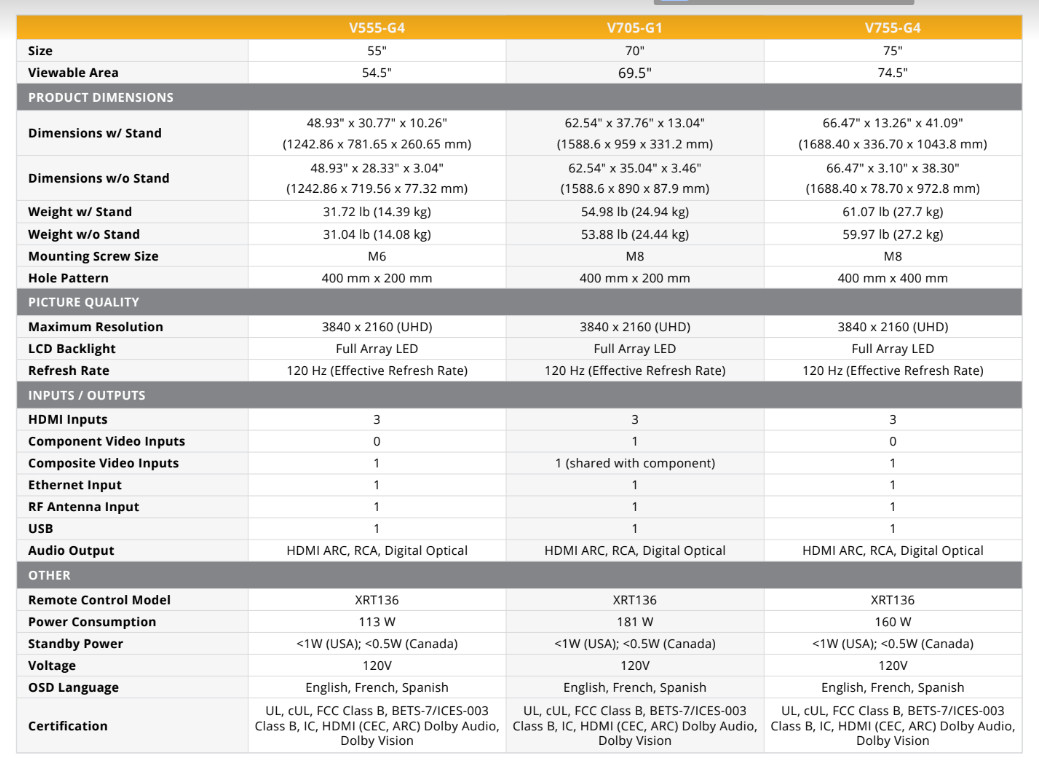
Regulatory Information
FCC Class B Radio Interference Statement
NOTE: This equipment has been tested and found to comply with the limits for a Class B digital device, pursuant to Part 15 of the FCC Rules. These limits are designed to provide reasonable protection against harmful interference in a residential installation. This equipment generates, uses and can radiate radio frequency energy, and if not installed and used in accordance with the instructions, may cause harmful interference to radio communications. However, there is no guarantee that interference will not occur in a particular installation. If this equipment does cause
harmful interference to radio or television reception, which can be determined by turning the equipment off and on, the user is encouraged to try to correct the interference by one or more of the following measures:
• Reorient or relocate the receiving antenna.
• Increase the separation between the equipment and receiver.
• Connect the equipment into an outlet on a circuit different from that to which the receiver is connected.
• Consult the dealer or an experienced radio/TV technician for help.
This device complies with Part 15 of the FCC Rules. Operation is subject to the following two conditions: (1) this device may not cause harmful interference, and (2) this device must accept any interference received, including interference that may cause undesired operation.
Notice
The changes or modifications not expressly approved by the party responsible for compliance could void the user’s authority to operate the equipment.
Shielded interface cables and AC power cord, if any, must be used in order to comply with the emission limits.
The manufacturer is not responsible for any radio or TV interference caused by unauthorized modification to this equipment. It is the responsibilities of the user to correct such interference.
This transmitter must not be co-located or operating in conjunction with any other
antenna or transmitter.
Operations in the 5GHz products are restricted to indoor usage only.
This equipment complies with FCC/ISED radiation exposure limits set forth for an uncontrolled environment. This equipment should be installed and operated with minimum distance 20cm between the radiator & your body.
FCC Warning
Changes or modifications not expressly approved by the party responsible for compliance with the FCC Rules could void the user’s authority to operate this equipment.
Caution
Always use a power outlet that is properly grounded
Canada Notice for License-Exempt Radio Apparatus
This device complies with Industry Canada’s license-exempt RSSs. Operation is subject to the following two conditions: (1) This device may not cause harmful interference, and (2) this device must accept any interference received, including interference that may cause undesired operation.
This device operates on a no-protection no-interference basis. Should the user seek to obtain protection from other radio services operating in the same TV bands, a radio license is required. Please consult Industry Canada’s document CPC-2-1-28. Optional Licensing for Low-Power Radio Apparatus in the TV Bands, for details.
